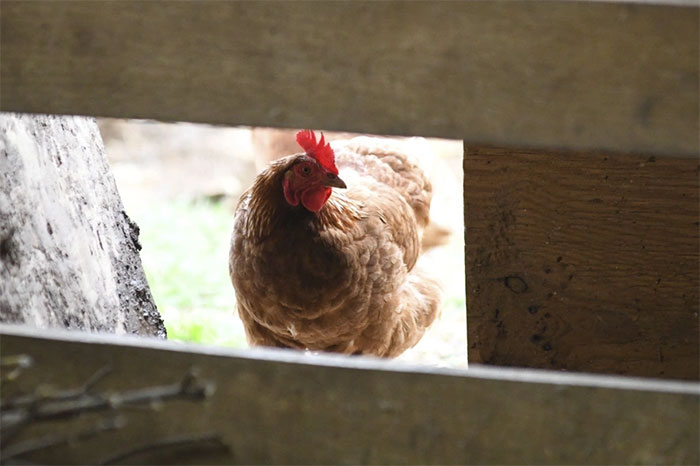Following the emergence of a case of Avian Influenza A(H5) after 8 years, this disease is receiving significant attention and concern from the community.
Understanding Avian Influenza
In mid-October, the Central Institute of Hygiene and Epidemiology reported a case of a 5-year-old child in Phu Tho testing positive for the Avian Influenza A(H5) virus. This is the most recent case of Avian Influenza in humans in Vietnam since February 2014.
Although well-controlled, this disease still raises many concerns. In this context, Dr. Phan Van Manh from the Emergency Department of the Central Tropical Hospital stated that the public should be aware of the risk of contracting the Avian Influenza virus.

The emergence of Avian Influenza cases after a long time raises community concerns. (Photo: WTHR).
What is Avian Influenza?
Dr. Manh explained that theoretically, the influenza virus belongs to the Orthomyxoviridae family, which includes four types: A, B, C (which can cause illness in humans), and D (primarily affecting livestock and not causing illness in humans).
While influenza virus C causes sporadic illness in humans and pigs, influenza viruses A and B appear seasonally in humans worldwide. Annual seasonal influenza outbreaks are estimated to cause about 3-5 million severe cases and approximately 290,000-650,000 deaths.
“Humans can also be infected with influenza virus A from animals (zoonotic influenza), such as avian influenza A, which is categorized into types: A (H5N1), A (H5N6), A (H7N9), A (H7N7), and A (H9N2), or swine influenza A including A (H1N1), A (H1N2), and A (H3N2)“, the expert noted.
Among these, avian influenza is caused by A type strains, which typically infect wild birds and domestic poultry. However, some strains can infect humans, such as H5, H7, and H9.
According to Dr. Manh, most cases of avian influenza in humans are caused by the Asian strains H5N1 and H7N9.

Avian Influenza can cause high mortality rates in domestic poultry and can transmit to humans. (Illustrative image: MPR).
Avian influenza infections usually show no symptoms in wild birds but can cause very high mortality rates in domestic poultry.
In humans, the mortality rate from infections with A (H5N1), A (H5N6), and A (H7N9) viruses is much higher than that of seasonal influenza A or B viruses. Meanwhile, most cases of infection with A (H7N7) and A (H9N2) tend to be milder.
In the past, the first cases of H5N1 infection in humans were detected in Hong Kong (China) in 1997. At that time, many patients exhibited severe respiratory symptoms, with a high mortality rate.
By 2003 and 2004, H5N1 infections in humans re-emerged and were mainly reported in Asia and the Middle East. Since 2014, cases of H5N6 infections in humans have also been recorded, all occurring in the Western Pacific region, mostly in China.
In early 2013, a widespread outbreak of H7N9 avian influenza occurred in several southeastern provinces of China. At that time, 1/3 of the cases regrettably resulted in death, primarily among the elderly.
Dr. Manh added, “Additionally, other avian influenza strains such as H5N8, H7N3, H7N7, H7N4, and H9N2 also occur but not frequently.”
How does Avian Influenza Virus exist in nature?
The Avian Influenza A virus has been isolated from over 100 different species of wild aquatic birds worldwide, including ducks, geese, swans, gulls, terns, herons, and sandpipers.
“These species can be infected with the virus in their intestines and respiratory tracts, from which they excrete through saliva, nasal secretions, and feces. Domestic poultry can be infected with the influenza virus through these natural sources of infection,” Dr. Manh analyzed.
Moreover, avian influenza viruses are classified into two types: low pathogenic (LPAI) and high pathogenic (HPAI).
The expert believes that low pathogenic avian influenza viruses cause asymptomatic or mild illness in poultry, such as feather ruffling and reduced egg production. In contrast, high pathogenic avian influenza viruses cause severe disease and high mortality rates in infected poultry.
“Chickens infected with HPAI A (H5) or A (H7) viruses can affect many internal organs with mortality rates reaching 90-100%, often within 48 hours,” he added.
How does Avian Influenza transmit to humans?
According to the expert, most human cases of avian influenza are due to transmission from animals (typically poultry) after inhaling or coming into direct contact with the secretions (saliva, mucus, or feces) of infected animals.
The direct transmission rate of the avian influenza virus from human to human is very limited. However, the influenza virus has a rapid gene mutation capability. Therefore, it could potentially lead to human-to-human transmission, resulting in a pandemic.
How to recognize a person infected with Avian Influenza?
“The symptoms of avian influenza are quite similar to those of seasonal influenza. However, the severity and mortality rates tend to be higher, depending on the virus strain,” Dr. Manh stated.
According to him, individuals infected with avian influenza may not show symptoms or may exhibit mild symptoms such as fever, cough, runny nose, nasal congestion, sore throat, muscle aches, headaches, and conjunctivitis.

Patients with Avian Influenza often have symptoms quite similar to seasonal influenza. (Illustrative image: towfiqu_barbhuiya).
Less common signs include diarrhea, nausea, vomiting, or seizures. Severe manifestations may include difficulty breathing or pneumonia, progressing to respiratory failure with a high mortality rate.
What to do when infected with Avian Influenza?
When clinical symptoms appear, along with a history of contact with someone infected with avian influenza or poultry in an area experiencing an outbreak, patients should suspect an avian influenza virus infection and immediately go to a medical facility capable of testing for influenza diagnosis, where they can be examined and diagnosed promptly.
Dr. Manh noted that Oseltamivir (Tamiflu) is the specific medication for treating avian influenza and should be administered as early as possible for unfortunate cases of infection.
On the other hand, the World Health Organization (WHO) recommends against using corticosteroids, passive immunotherapy, or macrolide antibiotics in cases of influenza.
“The use of antibiotics when patients do not have a bacterial superinfection is unnecessary and contributes to the development of antibiotic resistance,” Dr. Manh added.
Therefore, patients should not self-medicate when exhibiting symptoms of influenza. Instead, they should visit a medical facility for proper diagnosis and treatment.
Additionally, Dr. Manh recommends basic supportive treatment methods for influenza that people can perform at home, including rest, adequate hydration and nutrition, lowering fever with paracetamol when the temperature exceeds 38.5 degrees Celsius, and balancing fluids and electrolytes with oral rehydration solutions.
How to prevent Avian Influenza?
According to Dr. Manh, vaccination campaigns for poultry against H5 and H7 influenza viruses can help proactively prevent the spread of the influenza virus from wild birds to domestic poultry.
“When avian influenza is detected in poultry, we need to cull the infected flocks to prevent further spread,” the expert affirmed.
Moreover, the public should avoid unprotected contact with wild birds (even if they appear healthy) and with poultry showing signs of illness or death.
An important note is to avoid touching surfaces that may be contaminated with saliva, mucus, or feces from poultry.
When contact with sick poultry is necessary, people should use protective clothing such as gloves, medical masks, and eye protection, and wash hands with soap and water after contact.
Healthcare workers interacting with infected individuals should also use protective clothing. For interventions or aerosol-generating procedures, N95 masks should be used.
If infection with the virus is suspected, patients should isolate themselves, avoid contact with family members, wear medical masks, and go to the hospital for timely diagnosis.



















































